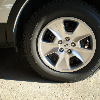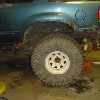I would go to your nearest autozone and have them use their scanner if they have one to monitor your O2 sensor. they also have loaner vacuum gauges, although I don't think its vacuum. I would look at the O2. you can test it with a multimeter as well but a scanner is easier and less risky than your multimeter.
or if no desire to check it you can just replace the O2 sensor. I am not certain if there are 2 on 93s or just 1, I know my 91 just has 1. but they are 50.99 there for a bosch OEM replacement. it does say 2 required so you will be out 100 bucks. if even just 1 is bad it will make your mileage poor. but then again it says 2 required for my 91 and it only has 1. so look under there
if you are good with a DMM here is the digital multimeter test procedure from autozone:
WARNING
An oxygen sensor must be tested with a digital voltmeter. If an analog meter is used for this purpose, the sensor may be damaged.
Testing With A Digital Mulitmeter
Connect the voltmeter between the O2 sensor wire and ground.
Backprobe the connector near the O2 sensor to connect the voltmeter to the sensor signal wire. If possible, avoid probing through the insulation to connect a meter to the wire.
With the engine idling, the sensor voltage should be cycling from low voltage to high voltage. The signal from most O2 sensors varies between 0 and 1 volt.
If the voltage is continually high, the air/fuel ratio may be rich or the sensor may be contaminated by RTV sealant, antifreeze, or lead from leaded gasoline.
When the O2 sensor voltage is continually low, the air/fuel ratio may be lean, the sensor may be defective, or the wire between the sensor and the computer may have a high-resistance problem.
If the O2 sensor voltage signal remains in a mid-range position, the computer may be in open loop or the sensor may be defective.
The sensor can also be tested after it is removed from the exhaust manifold.
Connect the voltmeter between the sensor wire and the case of the sensor.
Using a propane torch, heat the sensor element. The propane flame keeps the oxygen in the air away from the sensor element, causing the sensor to produce voltage.
While the sensor element is in the flame, the voltage should be nearly 1 volt.
The voltage should drop to zero immediately when the flame is removed from the sensor.
If the sensor does not produce the specified voltage or if the sensor does not quickly respond to the change, it should be replaced.
If a defect in the O2 sensor signal wire is suspected, backprobe the sensor signal wire at the computer and connect a digital voltmeter from the signal wire to ground with the engine idling.
The difference between the voltage readings at the sensor and at the computer should not exceed the vehicle manufacturer's specifications. A typical specification for voltage drop across the average sensor wire is 0.02 volt.
Now check the sensor's ground.
With the engine idling, connect the voltmeter from the sensor case to the sensor ground wire on the computer. Typically, the maximum allowable voltage drop across the sensor ground circuit is 0.02 volt.
Always use the vehicle manufacturer's specifications. If the voltage drop across the sensor ground exceeds specifications, repair the ground wire or the sensor ground in the exhaust manifold.
Most late-model engines are fitted with heated O2 sensors.
If the O2 sensor heater is not working, the sensor warm-up time is extended and the computer stays in open loop longer. In this mode, the computer supplies a richer air/fuel ratio. As a result, the engine's emissions are high and its fuel economy is reduced.
To test the heater circuit, disconnect the O2 sensor connector and connect a voltmeter between the heater voltage supply wire and ground.
With the ignition switch on, 12 volts should be supplied on this wire. If the voltage is less than 12 volts, repair the fuse in this voltage supply wire or the wire itself.
With the O2 sensor wire disconnected, connect an ohmmeter across the heater terminals in the sensor connector.
If the heater does not have the specified resistance, replace the sensor.
good luck and let us know










